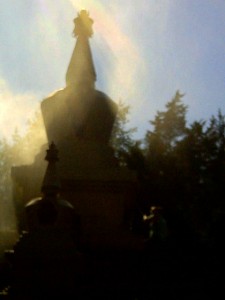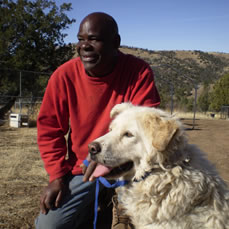The following post was contributed by Ani Kunzang Drolma:
Recognizing the Miraculous
Designed by the Buddha himself, Stupas are a display of enlightened mind in the world. Because of this they provide an opportunity for all beings to receive blessings by making offerings, circumambulating and taking care of them. These blessings occur whether we understand the nature of a Stupa or not; the seed of Buddahood or enlightened mind exists in all sentient beings and can be ripened by these blessings. It is like a call and response on an invisible, subtle level that can happen spontaneously without the process of ordinary, rational, thinking. A person who is not a Buddhist, perhaps not having any faith, may feel compelled to prostrate to a Stupa without comprehending why and may even be surprised at their own actions. This is the miraculous nature of Bodhicitta, the compassionate wisdom nature of enlightened mind. In whatever shape or form it exists in the world – as a Stupa or as an enlightened pure Teacher – it constantly communicates with each of us, with that very same nature that exists within.
Recently at the Migyur Dorje Stupa in MD, which is currently being cleaned and repaired, a turtle walked up to the Stupa and laid a clutch of eggs right in front. Normally a turtle would not go to an open public space to lay her eggs, but this turtle was responding to the presence of the extraordinary, the Stupa, and making an offering. This occurred while Jetsunma was engaged in prayer in her home on the Temple land. At about the same time the stillness of the air was transformed by a rising wind, as if the elements too were acknowledging the presence of the sacred.
Some days later, cleaning and other upkeep was being undertaken at Jetsunma’s Long Life Stupa. A circular rainbow appeared around the Stupa, which could be seen from every angle. Those present knew they were witnessing the miraculous, and responded with devotion and joy.
In his extraordinary and lyrical book, “Magic Dance, The Display of the Self-Nature of the Five Wisdom Dakinis”, HE Thinley Norbu Rinpoche, who sadly recently passed from this world, speaks about miracles in the chapter on Personal and General Phenomena. Contemplating it helps unravel the confusion about miracles and the presence of enlightened mind in our world.
He says, “Until we become enlightened, personal and general phenomena communicate with each other. Because of this communication it is possible for the personal spiritual qualities of enlightened beings to become conspicuous through their history and to remain like echoes in the general spiritual system even though the source of their pure self-visible phenomena is invisible to us until enlightenment. For individuals as well as for groups, when the contributing circumstance, the sublime history of enlightened beings, joins with the root circumstance, our secrete essence enlightenment seed, the seed can awaken and grow. By the joining of these two circumstances, our spiritual qualities increase.
When we remember great sublime beings such as Milarepa, Jesus, Buddha Shakyamuni, and Padmasambhava, we think they performed miracles intentionally. Of course, it is good to feel this way because by trying to connect with their pure secret essence we accumulate merit. But the perception of this intention is only our general group phenomena agreement. Actually these miracles only appeared when sublime beings used the pure undivided secret essence of the elements, which exists from the beginning, in order to make truth conspicuous……The gross and subtle elements are always connected to their secret essence. People who saw Jesus walking on the water had a good karmic link with him, because with their gross and subtle elements’ phenomena, they could connect to the pure secret essence of what they perceived as a miracle.”
Pure enlightened mind is ever-present, whether we recognize it with our ordinary minds or not. As Rinpoche says, “the primordial secret essence of the elements, which is never divided, always vast, inseparable pervading everywhere.” Miracles occur when, through the kindness of a pure Teacher, we glimpse the blessings of the primordial secret essence and know it to be extraordinary. This encourages us to increase our faith and devotion towards that which is truly holy. As we acknowledge and pay homage to the extraordinary nature of this essence in the form it has appeared in our lives – through our Teacher or Stupa or sacred statue – we move towards a state of recognition and the awakened state of enlightened mind, or Bodhicitta.
There is a beautiful prayer we say, to invoke the qualities of Bodhicitta:
“May all beings know happiness and the causes of happiness,
May they be free from suffering and the causes of suffering,
May they never be separated from the sacred happiness which is sorrowless,
And free from the knots of hope and fear may they believe in the equanimity of all that lives”
Recognizing miraculous events reminds us that we are never separate from that sacred happiness. It is through our devotion and the immeasurable kindness of our Teacher that such opportunities arise. It is helpful to contemplate and rejoice in this so that we can better discriminate that which is sacred, and deepen in our recognition.

